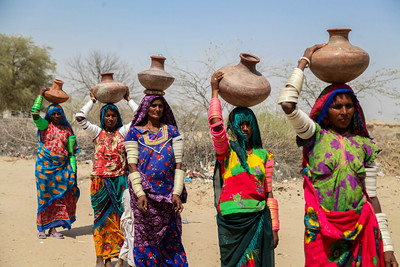
Poem ‘Sindhi Woman’ is part of private sector education institutions’ syllabus as the Sindhi woman symbolizes a character of strength and courage who never submits to heavy odds.
Jon Howie Stallworthy, a British poet, biographer and literary scholar, who was born on 18 January 1935 and died on 19 November 2014 at the age of 79, might have visited Karachi in the early years of Pakistan, where he saw hard working Sindhi women and wrote a poem titled ‘Sindhi Woman’. The poem was published in his poetry book in 1963.
Jon Stallworthy was born in London to New Zealand parents, John (later Sir John) Stallworthy, a surgeon and professor of obstetrics and gynecology, and his wife, Peggy (nee Howie), who is credited with giving her son his “first taste of poetry” with the nursery rhymes she sang to him as a child. Educated at the Dragon school, Oxford, and Rugby, Stallworthy served as second lieutenant in the Nigeria Regiment of the West African Frontier Force in the mid-1950s. After national service, he studied English literature at Magdalen College, Oxford, where in 1958 he won the Newdigate prize for his poem The Earthly Paradise.
Jon Stallworthy was the poet of such repute that the English Faculty and Wolfson College had announced early this year the poetry competition for Oxford postgraduate students. He was a fellow of The British Academy, and The Royal Society of Literature. His collections of poems are mostly in the traditional forms of examination of war. His several volumes of poetry including Rounding the Horn, Collected Poems, Body Language, and Survivor’s song were published.
Stallworthy’s poem ‘Sindhi Woman’ is much praised and is part of syllabus of some private educational institutions. The poem consists of only two Stanza’s but these few lines speak a lot. Here is the poem:
Sindhi Woman
Barefoot through the bazaar,
And with the same undulant grace
As the cloth blown back from her face,
She glides with a stone jar
High on her head
And not a ripple in her tread.
Watching her cross erect
Stones, garbage, excrement, and crumbs
Of glass in the Karachi slums,
I, with my stoop, reflect
They stand most straight
Who learn to walk beneath a weight!
The Sindhi Woman in this poem is symbol of strength, hard work and courage to face the difficult times of life, as is being taught at private sector education institutions. The students are told, “ The poem is about the importance of work. Work brings us respect and reward. It keeps us strong and stout. The woman carrying a heavy jar on her head is a lesson to all mankind. “
“Her steadfastness leaves a message for us that we should not lose heart in the face of worldly burdens and responsibilities. We should rather handle all these manfully. We should be ever ready to keep up our morale in hardship. The poet pays rich tribute to hard work.
“It is the work that keeps man rhythmic and vigorous. The poet is impressed by the determination and energy of the Sindhi woman. He praises her for her strong will and conveys the message to the reader that only those are successful who never submit or yield against heavy odds”.
According to an American blog writer McKinley Pugh, the poem is full of wisdom. The whole poem is actually just two sentences, broken into two stanzas. The first stanza, or sentences, appears to be only describing a particular scene, like many other poems. The word “bazaar” immediately places the reader in a third-world, Middle Eastern market. “Barefoot” suggests poverty but also strength and tenacity. With this setting, both visual and emotional, immediately put in place, Stallworthy uses precise detail — the cloth, the placement of the jar, her walk — with words like “grace,” “glides,” “blown,” “high,” and “ripple” to put a sense of beauty, even accomplishment, to the stereotyped image of an African women carrying a load on her head. The image itself may be unusual in its culture, but Stallworthy describes it in such a way that the usual pity that comes along with such description is completely erased – Stallworthy puts worth and dignity to this woman.
“With this set up, the reader still carries the grace of the woman with him as he reads Stallworthy’s description of her surroundings. The poem drops back to reality, where the woman really is poor, and by our, American terms, extremely unfortunate. But even as Stallworthy depicts “garbage, excrement, and crumbs/ of glass in the Karachi slums,” the reader retains an admiration of the woman, who can walk with such grace, barefoot, though it all. Stallworthy nurtures this feeling by comparing his own stoop to the woman’s straight back. His personal comparison seals the attitude he has been feeding and makes his point come across as humble and as compassionate as possible: “they stand most straight/ who learn to walk beneath a weight.”
Throughout the poem, Stallworthy follows a simple, though not common, rhyme scheme: abbacc. The rhymes are not jarring. Only the last couplet in each stanza stands out as obviously rhyming. This is important because Stallworthy has no set rhythm to his lines. The words flow, but they could easily sound like prose. However, because of the rhymes, the words sound just a little more poetic, a little more composed than they would ordinarily. This parallels the image of woman Stallworthy is describing. It could be ordinary or taken for granted, but it is actually far more than first meets the eye. And, of course, the rhyming of the last two lines highlights the thesis of the poem.
“Sindhi Woman” is a beautifully written poem that breaks away from the stereotypes of both poverty and so-called “character-building” to portray the spirit of one who has overcome, without losing the meaning in a series of devaluing clichés”, McKinley concludes.
________________________
Source: Mckinley Pugh Blogs, The Guardian, Wolfson Oxford UK, Educational Lodge, Academic Stuff, Graduate Way